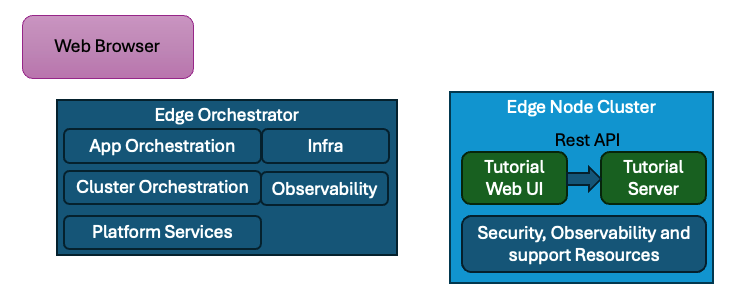Develop a Sample App#
As outlined in the Developer Workflow Develop Applications, the most important first step is to design your application. This tutorial will create a simple application that will demonstrate the basic concepts of Edge Orchestrator Application Orchestration.
Design the Application#
In the example, you will create a simple web application that will maintain a counter from a microservice and display the current count on a web page. The microservice will have a simple REST API that will allow querying, incrementing, decrementing and zeroing of the counter.

Choose a Framework and Language#
Choosing a framework and language is an important step in the development process. You should thoroughly research the options available and choose the best framework and language for your application. For this tutorial, you will select simple options that are easy to use, have a large community, and may be familiar to many developers.
Tutorial Server#
Since this is a simple application, you will use the FastAPI framework to create the server portion. Fast API is a lightweight web framework written in Python* that is easy to use and has a built-in Swagger UI. This will allow you to easily test the API.
Tutorial Web UI#
For the web UI, you will use Next.js* framework, which is a progressive JavaScript* framework that is easy to use and has a large community. It uses the React framework to create the UI components. Use the Axios library to make the API calls.
The development will be done in the TypeScript language. The Next.js tools will be bundled and distributed as “minified” JavaScript* language to work with all modern browsers.
Ultimately, it is the Web Browser that will run the Tutorial Web UI application. The microservice’s role is just serving up the static HTML, CSS, and (minified) JavaScript files. For this you will use the NGINX* web server, which has many other functions that help route the traffic to the Tutorial Server application.
Note
The web UI could be developed using any number of frameworks and languages. You used Next.js framework here because it is easy to use and has a large community. There are many other Web Servers that could be used to serve the pages, including a Content Delivery Network (CDN), but you used NGINX to keep it in the microservice and have the same method of deployment for both frontend code and backend code.